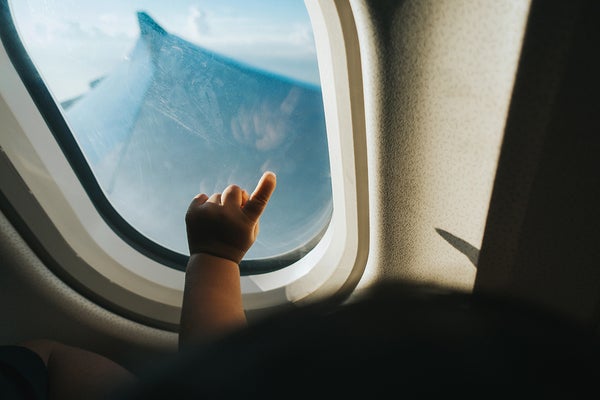It’s a perfectly sunny day, with a clear blue sky. The pilot just announced that your flight has reached cruising altitude, so the seat belt sign has been turned off. Passengers are moving about the cabin. Suddenly the plane starts shaking. You instinctively grab the arm of your chair. Passengers who have stood up brace themselves. A baby starts crying.
A minute later the alarm passes, your body relaxes, and you exhale deeply. Then the plane drops like a rock. Your stomach leaps into your throat. But there’s no storm outside, not even clouds. What’s going on?
This clear-air turbulence, as it’s called, is caused by patches of air swirling chaotically within the world’s jet streams—strong air currents that circle the globe from west to east and that we see on weather maps as wide, wavy lines that bend around low- and high-pressure centers. Airlines like to fly within these bands of fast-moving air to boost speeds and reduce travel times if the bands are near enough to the flight’s desired direction. The swirls, invisible to the eye, batter a plane’s wings. And when the battering is strong enough, it jerks the plane up or down. Passengers freeze, and flight attendants stumble. Over the past four decades clear-air turbulence has increased by up to 55 percent in various regions around the world. Models predict another 100 to 200 percent increase over the next 30 to 60 years. Each time the thumping arrives, it strikes with no warning.
Pilots can spot turbulence ahead of them relatively easily when it’s inside a storm or among clouds. Onboard radar can track the movements of rain drops in the distance to reveal the turbulent motion of air. Pilots can then forewarn passengers and crew, encouraging them to take their seat and buckle up before a jolt hits. Turbulence in clear air, however, is invisible to radar; pilots typically don’t know it’s there until the plane hits it.
Cloudy turbulence is created by a heating effect induced by the sun. When dawn breaks, the sun starts warming the ground, which in turn heats air near the surface. This warmer air is less dense than the colder air above it, so it rises. The displaced cold air falls, and the process repeats, setting up so-called convection currents. The up and down drafts of these currents push against the wings of planes, and if the shoves are strong and sudden, drinks start sloshing.
Clear-air turbulence occurs almost exclusively within jet streams. The fast band of air in a jet stream (envision a rectangular tube) shears the slower air that resides just above and below it, destabilizing the jet stream’s somewhat flat top and bottom boundaries and changing them from firm to fuzzy. Simultaneously, however, density differences between the jet stream’s air and the air above and below it restabilize the boundary.
Most of the time the stabilizing effect overcomes the destabilizing one, giving you a smooth ride. But if the wind shear becomes strong, the destabilization force can win the tug-of-war. The result is chaotically moving air that pushes abruptly up and down on the wings.
By pouring through historical flight and weather data, Paul Williams and his colleagues at the University of Reading in England found that turbulence in the North Atlantic jet stream increased in frequency by 17 to 55 percent from 1979 to 2020. The greatest increase was for the most severe class of turbulence, defined as having a g-force greater than 1 g. At this g-force, anything that isn’t bolted to the plane, including your stomach, will float momentarily because the turbulence causes the plane to accelerate downward faster than gravity does. If you’re not buckled up, you will lift out of your seat as the plane rapidly drops a few tens of meters.
What does this increase mean for your average flight? First, severe turbulence is relatively rare. In-flight measurements show that roughly 0.1 percent of the atmosphere at cruising altitudes contains severe turbulence. “That equates to around 30 seconds on an average eight-hour flight,” says Williams, an atmospheric science professor. A more likely scenario, he says, is that for every 10 flights a person takes, nine will have no severe turbulence and one will have several minutes of it.
Moderate to light turbulence is more common and what most of us will encounter. In moderate turbulence, the jumps and drops in altitude are typically a few meters. Williams says that today an eight-hour flight might contain 10 to 15 minutes of clear-air turbulence, but projections indicate that the extent of this turbulence will double or triple over the next few decades as warming from climate change increases wind shears in the jet stream.
Because more frequent jolts are likely to result in more wear and tear on planes, airlines may experience higher repair costs. Fliers might also encounter more harried parents, like me, weary from trying to keep their young child contained in their chair every time the seatbelt sign lights up. Those lift-latch buckles are just too easy for small hands to operate.
